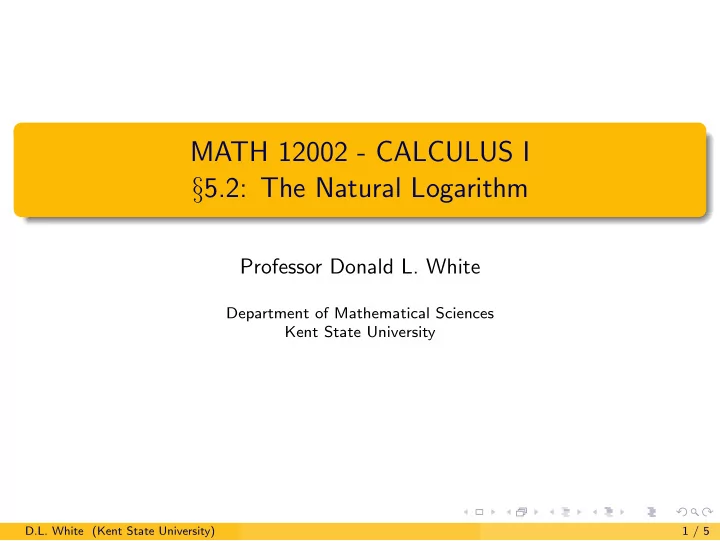

MATH 12002 - CALCULUS I § 5.2: The Natural Logarithm Professor Donald L. White Department of Mathematical Sciences Kent State University D.L. White (Kent State University) 1 / 5
The Natural Logarithm Function Recall that for n � = − 1, � 1 n + 1 x n +1 + C . x n dx = But the function f ( x ) = x − 1 = 1 x is continuous on the interval (0 , ∞ ), hence f has an antiderivative also, by the Fundamental Theorem. In particular, if a > 0, then � x 1 g ( x ) = t dt a is an antiderivative of f . We define the natural logarithm function to be the antiderivative of f whose value at x = 1 is 0: Definition The natural logarithm function is the function ln x , with domain (0 , ∞ ), defined by � x 1 ln x = t dt . 1 D.L. White (Kent State University) 2 / 5
Basic Properties � x 1 Basic properties of the function ln x = t dt and its graph include: 1 The domain of ln x is (0 , ∞ ), i.e., all x > 0. dx ln x = 1 d x by the Fundamental Theorem of Calculus. dx ln x = 1 d Since x > 0 for all x > 0, ln x is always increasing. In particular, ln x is one-to-one. d 2 dx 2 ln x = − 1 Since x 2 < 0 for all x > 0, ln x is always concave down. x → + ∞ ln x = + ∞ , so there is no horizontal asymptote. lim x → 0 + ln x = −∞ , so x = 0 is a vertical asymptote. lim D.L. White (Kent State University) 3 / 5
Basic Properties � 1 1 ln 1 = t dt = 0. 1 � x If x > 1, then since 1 1 t > 0 for 1 � t � x , ln x = t dt is the area 1 under the graph of y = 1 t from t = 1 to t = x : § 5.2 FIGURE 1 Hence for x > 1, ln x > 0. � 1 If 0 < x < 1, then since 1 1 t > 0 for x � t � 1, t dt is the area x under the graph of y = 1 t from t = x to t = 1: § 5.2 FIGURE 2 � 1 1 Hence for 0 < x < 1, − ln x = t dt > 0, and so ln x < 0. x D.L. White (Kent State University) 4 / 5
Basic Properties Given the properties we have listed, the graph of y = ln x is as in the figure below: § 5.2 FIGURE 4 dx ln x = 1 d We have x for all x > 0, hence ln x is continuous on (0 , ∞ ), ln 1 = 0, and x → + ∞ ln x = + ∞ , so ln x > 1 for some x > 1. lim By the Intermediate Value Theorem and the fact that ln x is one-to-one, there is a unique real number e such that ln e = 1: § 5.2 FIGURE 5 The number e is irrational and e ≈ 2 . 718281828459045 . . . D.L. White (Kent State University) 5 / 5
Recommend
More recommend